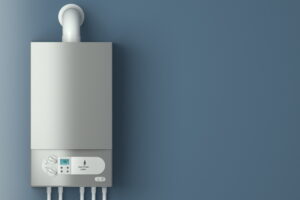Hot water is an essential part of our daily lives, whether it’s for showering, cooking, or cleaning. When it comes to choosing a water heater for your home, you’ll likely encounter two popular options: the traditional standard tank water heater and the innovative tankless water heater.
Both systems have their own set of advantages and considerations, making it important to understand the differences between them to make an informed decision. In this blog, we’ll compare the two options across various aspects to help you determine which one best suits your needs.
- Heating Mechanism:
- Standard tank water heaters store and heat a fixed amount of water in a large tank. The water is constantly heated, even when not in use, to ensure hot water is readily available.
- Tankless water heaters heat water on demand. They don’t store water in a tank; instead, they heat water as it flows through the unit, providing an endless supply of hot water.
- Energy Efficiency:
- Tank water heaters can experience standby heat loss, where the stored water loses heat over time, causing the unit to use energy to maintain the desired temperature.
- Tankless water heaters are generally more energy-efficient because they only heat water when needed. This eliminates standby heat loss, resulting in potentially lower energy bills over time.
- Space Requirements:
- Tank water heaters are larger and require dedicated space for the storage tank. They are suitable for homes with available space like basements or utility rooms.
- Tankless water heaters are compact and wall-mounted, saving valuable space. They are ideal for smaller homes or those looking to optimize space usage.
- Installation and Maintenance:
- Standard water heater installation involves connecting the tank to water and gas lines. Maintenance includes occasional flushing to remove sediment buildup.
- Tankless water heater installation can be more complex due to specific venting requirements and gas line considerations. Maintenance includes descaling to prevent mineral buildup in the heat exchanger.
- Initial Cost:
- Tank water heaters generally have a lower upfront cost compared to tankless units.
- Tankless water heaters have a higher initial cost due to the advanced technology and installation requirements.
- Long-Term Cost Considerations:
- While the initial cost is lower, the ongoing energy consumption and potential repair/replacement costs of the standard tank-style water heaters might result in higher long-term expenses.
- Higher energy efficiency and longer lifespan might offset the higher initial cost for a tankless unit in the long run.
- Hot Water Supply:
- Tank water heaters can run out of hot water if the stored supply is depleted. Recovery time for reheating the tank can be a concern during high-demand periods.
- Tankless water heaters provide a continuous supply of hot water, as water is heated on demand. However, the flow rate might be limited if multiple fixtures are running simultaneously.
Choosing between a standard tank water heater and a tankless water heater depends on your specific needs and preferences. If space, energy efficiency, and continuous hot water are priorities, a Navien tankless water heater could be the best option.
On the other hand, if you’re looking for a more budget-friendly initial investment and have ample space, a Bradford White tank water heater might be suitable. It’s essential to consider factors like installation, maintenance, energy costs, and long-term benefits to make the right choice for your home and lifestyle.
Contact Platinum Plumbing & Heating, Inc. today to schedule an appointment with our pros.

